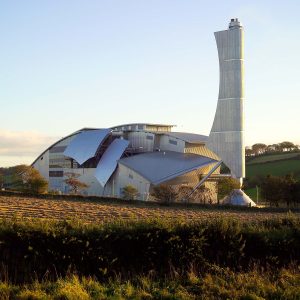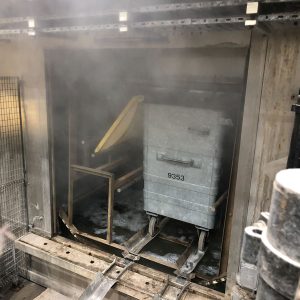Summary
1000 Kilogramme an hour hazardous waste incinerator installed on the Isle of Wight.
- C1000 Hazardous Waste Incineration Facility
- Stepped Hearth Incinerator
- Hydraulically Powered Automatic Loading
- Waste Oil Recycling Burners
- Integrated Into Existing Municipal Waste Systems
- Sophisticated Central Control Systems
How Proper Waste Management Protects the Environment
In 2006, Addfield successfully installed a state-of-the-art medical waste treatment plant on the Isle of Man, UK, capable of handling up to 1000kg per hour of hazardous waste streams. The plant was seamlessly integrated into the existing municipal waste site, effectively managing diverse waste streams, including clinical waste, animals, and sewage filtering.
Addfield solution was tailored to meet the customer’s unique needs, with a machine specifically designed and built to process hazardous waste streams efficiently. The installation of this plant has provided the Isle of Man with a reliable and sustainable solution for managing hazardous waste, thus ensuring the protection of public health and the environment.
Tailored Solution for Hazardous Waste on Isle of Man, UK
The implementation of the waste treatment plant was driven by two main objectives - offsetting the environmental impact of waste transportation and minimising biosecurity risks associated with waste movement. The plant utilised waste oil to supplement the burn process to achieve these goals, resulting in a more efficient and cost-effective waste management solution.
The business case for the plant was further strengthened by the significant reduction in transportation costs incurred by transporting waste off the island. Implementing the waste treatment plant has not only mitigated the environmental impact of waste transportation but also provided a sustainable and reliable solution for managing hazardous waste streams.
Overall, implementing the waste treatment plant has proved to be a successful case study in mitigating environmental and biosecurity risks while achieving cost savings and sustainability.
C1000 Thermal Treatment Plant
Automated Waste Management Solution
The C1000 is a state-of-the-art incineration line that provides a fully automated waste management solution. The system utilises advanced technology to identify the waste type and efficiently process it, ensuring maximum burn rate and minimal environmental impact.
Upon arrival, the incoming wheelie bins are equipped with data information tags and loaded onto the automated bin rail. As the bins move down the rail, the tags are read, and the waste type is identified. The bin is then weighed and emptied into the loading hopper using a hydraulic ram charger system. Once emptied, the bin is automatically manoeuvred to a bin washer system, where it is thoroughly cleaned inside and out using steam.
The automated waste management process continues until the hourly burn rate has been achieved, which is determined by the computer algorithm. The waste steam generated during the bin washing process is extracted and fed back into the incinerator to remove any odours and hazards.
The C1000 thermal treatment plant provides a sustainable and reliable solution for managing diverse waste streams. The automated process not only maximises the efficiency of waste processing but also ensures complete waste elimination and minimised environmental impact.
Efficient Waste Elimination through Advanced Incineration Technology
The incineration plant features a primary incineration chamber and a secondary after-chamber that utilises advanced technology to ensure efficient waste elimination. The primary chamber is fed from the hydraulic loader and comprises a fully bricked stepped hearth with a multi-point hearth sweeping system. The ash produced during combustion is deposited into a receiving wheeled bin via an automatic de-ashing system.
The secondary after chamber provides a two-second retention time at a minimum temperature of 1100 deg.C. It is designed to oxidize fluoxidise thoroughly and is the first stage of the gas cleaning system. Additionally, the chamber is equipped with an SNCR de-NOx kit as a precautionary measure. However, the combustion process proved so efficient that the unit was never used. Oxygen sensors installed on the secondary chamber ensure that the output contains only 6% oxygen.
This project has included:
- Turn-key supply
- Design – engineering – manufacturing – installation – commissioning – training – proving – handover
- Compliant to the Waste Incineration Directive EC 2000/76 and Industrial Emission Directors IED 2010/75/EU
- Automatic loading bin tipper system
- Integrated bin cleaning facilities
- Automatic de-ashing
- Waste oil burners
- 4000kw thermal recovery boiler
- De-Nox kit installed
- Sorbent reagents used for further neutralisation
- Dry ceramic filter system
- Full MCERT’s accredited 24/7 online continuous emission monitoring
Efficient Advanced Incineration Technology
The incineration plant's innovative technology ensures that hazardous waste is effectively eliminated with minimal environmental impact. The system's high efficiency guarantees that the waste is completely burned, and the gas cleaning system ensures that the flue gas is thoroughly treated before release. The advanced technology used in the plant provides a sustainable and reliable solution for managing hazardous waste streams.
This installation includes a transit duct connecting the secondary chamber to a 4000kw thermal recovery boiler. The system ensures efficient waste management, and a flue gas filtration system at the main municipal waste site further enhances environmental sustainability.
The plant is equipped with sophisticated PLC controls accessible from various stations around the plant. All these stations are interconnected, and the central control room provides complete feedback on all possible variables. This advanced control system ensures that the waste management process runs smoothly and efficiently.
The clinical waste system has been operating for thousands of cycles and is still going strong. This success is due to the innovative design and construction of the system, which was built to handle various hazardous waste streams, including clinical waste, animals, and sewage filtering.
The efficient waste management has helped offset environmental and biosecurity issues while providing cost benefits to the plant owners. Overall, the clinical waste system is an excellent example of how innovative technology can provide efficient and sustainable waste management solutions.




